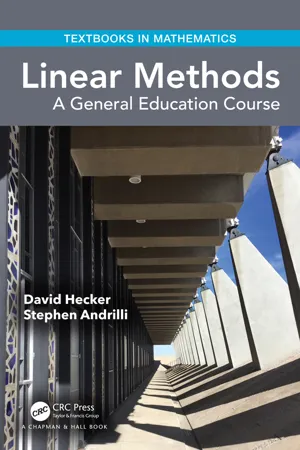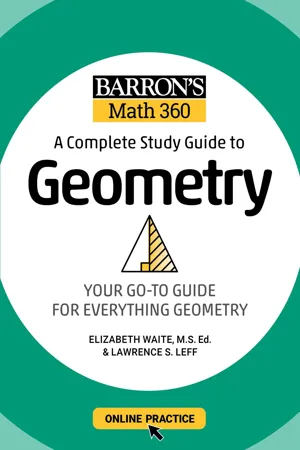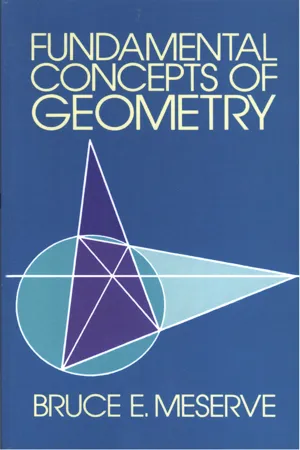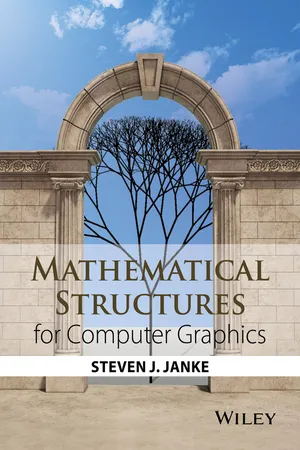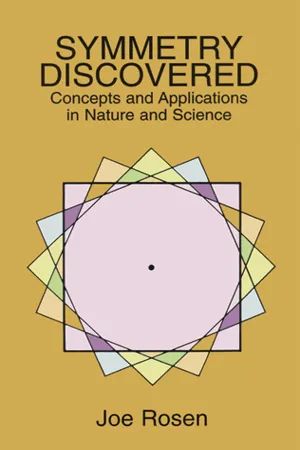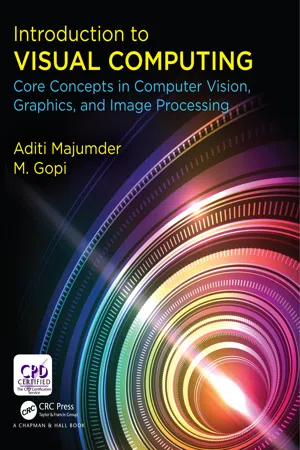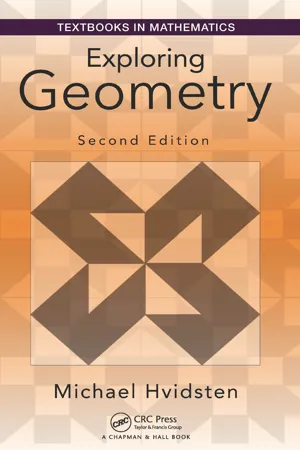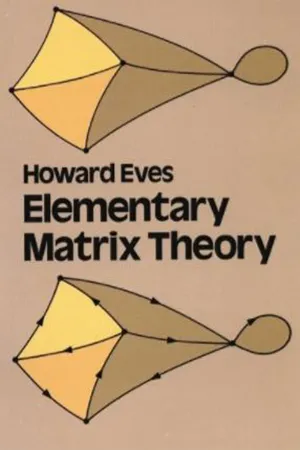Mathematics
Similarity Transformations
Similarity transformations in mathematics refer to transformations that preserve the shape of an object while possibly changing its size and orientation. These transformations include translations, rotations, reflections, and dilations. They are used to study geometric figures and are important in fields such as geometry, computer graphics, and engineering.
Written by Perlego with AI-assistance
Related key terms
Related key terms
1 of 4
Related key terms
1 of 3
12 Key excerpts on "Similarity Transformations"
- eBook - ePub
- Walter Meyer(Author)
- 2022(Publication Date)
- Chapman and Hall/CRC(Publisher)
7 Transformation Geometry III: Similarity, Inversion and ProjectionsDOI: 10.1201/9780429198328-7Until now, we have studied isometries extensively, but they are not the only geometric transformations which are theoretically interesting and useful. In this chapter, we introduce other types of transformations and their applications in computer graphics, cartography, the theory of mechanical linkages, and computer vision.Prerequisites: Sections 1 and 2 rely on some facts about similar triangles (material covered in Section 4 of Chapter 2 ).In Section 1 , the composition of transformations (covered in Section 2 of Chapter 4 ) comes up but can be avoided. In any case, only the definition is needed.In Sections 3 , 4 , 5 , we undertake our most extensive study of three-dimensional geometry, using vector equations of lines and planes (covered in Sections 1 and 2 of Chapter 5 ), as well as the axioms pertaining to three dimensions (Section 3 in Chapter 1 ).Section 1. Central Similarity and Other Similarity Transformations
We are surrounded by pictures which are not life-size: huge faces on billboards, tiny ones on our drivers' licenses, etc. The process of getting an image blown up or squeezed down can be thought of in terms of the geometric transformation called central similarity.Definition: Let C be any fixed point in the plane and r any positive number. The transformation called1 central similarity SC,ris defined as follows:- The image of C is C itself.
- For any point other point P, the image P'—also denoted SC,r(P)—is the point with the following two properties:
- CP' = r CP.
- P and P' are on the same side of C on the line .C P↔
The point C is called the centre of the transformation and r is called the ratio of similarity.It is also possible to define central similarity for a negative value of r: First, take the absolute value of r and proceed as above. Finally, apply rotation of 180° to the resulting point. Figure 7.1 shows central similarities with r = 2 and −2. Unless we say otherwise, we deal exclusively with central similarities with r - eBook - ePub
Linear Methods
A General Education Course
- David Hecker, Stephen Andrilli(Authors)
- 2018(Publication Date)
- Chapman and Hall/CRC(Publisher)
• Geometric transformation: A transformation of the plane whose movement of points can be described geometrically. Rotations, reflections, scalings, and translations are examples of geometric transformations.• Image: The resulting point (or vector) obtained from a given point (or vector) from a transformation of the plane.• Matrix transformation of the plane: A movement of the points in the plane obtained by matrix multiplication.• Preserving angles: A transformation of the plane preserves angles if the angle between all pairs of line segments that share a common endpoint is the same as the angle between their images. Similarities preserve angles.• Preserving distances: A transformation of the plane preserves distances if the distance between any pair of points in the plane equals the distance between their images. Rotations, reflections, and translations all preserve distances. Any matrix transformation that preserves distances also preserves angles. (See Exercise 13.)• Reflection about a line: A transformation of the plane in which the image of each point in the plane is on the opposite side of the line of reflection, the segment connecting a point and its image is perpendicular to the line of reflection, and that segment has its midpoint on the line of reflection. Points on the line of reflection remain fixed.• Reflection through a point: A scaling with scaling factor −1. (See Exercise 8 in this section, and Exercises 3(a) and 4(d) in Section 7.3 .)• Rotation: A transformation of the plane in which every point is rotated by the same angle about a fixed point. Unless stated otherwise, rotations are assumed to be counterclockwise.• Scaling: A transformation of the plane that multiplies every vector by the same scalar c.• Scaling factor: The scalar used in a scaling transformation.• Similarity: A transformation of the plane that preserves angles. Scalings, rotations, reflections, and translations are all similarities.• - eBook - ePub
- Walter A. Meyer(Author)
- 2006(Publication Date)
- Academic Press(Publisher)
Chapter 7 Transformation Geometry III: Similarity, Inversion, and ProjectionPrerequisites: Sections 7.1 and 7.2 rely on some facts about similar triangles (material covered in Section 2.4 ). In Section 7.1 , composition of transformations (covered in Section 4.2 ) comes up but can be avoided. In any case, only the definition is needed. In Sections 7.3 , 7.4 , and 7.5 we undertakeour most extensive study of three-dimensional geometry, using vector equations of lines and planes (covered in Sections 5.1 and 5.2 ) as well as the axioms pertaining to three dimensions (Section 1.3 ).Up to this point, we have studied isometries extensively. But isometries are not the only geometric transformations that are theoretically interesting and practically useful. In this chapter we introduce some other types of transformations and their applications in computer graphics, cartography, the theory of mechanical linkages, and computer vision.7.1 Central Similarity and Other Similarity Transformations in the Plane
We are surrounded by pictures that are not life size: huge faces on billboards, tiny ones on our drivers’; licenses, etc. The process by which an image gets blown up or squeezed down can be thought of in terms of the geometric transformation called central similarity.DEFINITION
Let C be any fixed point in the plane and r any positive number. The transformation called1central similarity SC,ris defined as follows:(a) The image of C is C itself.(b) For any other point P , the image P ′ — also denotedSC,r(P ) — is the point with the following two properties:1. CP ′ = r CP.2. P and P′ are on the same side of C on the line .The point C is called the center of the transformation, and r is called the ratio of similarity.It is also possible to define central similarity for a negative value of r : First take the absolute value of r and proceed as before. Finally, apply rotation through 180° to the resulting point. Figure 7.1 shows central similarities with r = 2 and −2. Unless we say otherwise, we deal exclusively with central similarities with r - eBook - ePub
Making Sense of Mathematics for Teaching Grades 6-8
(Unifying Topics for an Understanding of Functions, Statistics, and Probability)
- Edward C. Nolan, Juli K. Dixon(Authors)
- 2016(Publication Date)
- Solution Tree Press(Publisher)
As students transition from grades 6–8 into high school, transformations are incorporated not only in the geometry curriculum, but in algebra as well. Transformations include four main types: (1) reflections, (2) translations, (3) rotations, and (4) dilations. Each transformation impacts shapes in different ways. Transformations are used to examine ideas of congruency and similarity as well as scale factor in meaningful ways.Consider the transformations task in figure 5.26 . You may want to make a copy of the diagrams in figure 5.26 before proceeding. For each transformation, use the pre-image and your understanding of the transformation to draw the location of the image.Complete each of the described transformations.Figure 5.26: Reflection, translation, and rotation of a triangle task.How did you determine the locations of the images? What properties are important to consider? With which transformation were you most comfortable? Did any of them create a challenge for you?Visit go.solution-tree.com/mathematics for a free reproducible version of this figure.A reflection is like using a mirror. An object is reflected about a line, and the line becomes an axis of symmetry for the pre-image to the image. Every part of the pre-image (Δ ABC ) on one side of the line of reflection is on the opposite side of the line of reflection in the image (Δ A 'B 'C ') (see figure 5.27 ).What do you notice about the pre-image and the image? Are they congruent or similar? What do you notice about their orientation? In the case of a reflection, the orientation is reversed, but the pre-image and image are congruent shapes. What is the same and what is different between the pre-image and the image? Every point in the image is the same perpendicular distance from - Lawrence S. Leff, Elizabeth Waite(Authors)
- 2021(Publication Date)
- Barrons Educational Services(Publisher)
8 TRANSFORMATION GEOMETRYWHAT YOU WILL LEARN
In this chapter you will learn: •that a geometric transformation may change the position, orientation, or size of an object; •transformations may produce images that are congruent or similar to the original figure; •different types of symmetry; •how to apply transformations using coordinates; •the single transformations that are equivalent to performing consecutive reflections either over two parallel lines or over two intersecting lines.SECTIONS IN THIS CHAPTER•Terms and Notation•Congruence Transformations•Classifying Isometries•Size Transformations•Types of Symmetry•Transformations in the Coordinate Plane•Composing Transformations•Congruence Proofs Using TransformationsTerms and Notation
ONE-TO-ONE MAPPINGS
A mapping between two sets is a pairing of their elements. Suppose the members of set X are three married women, and the three members of set Y are their husbands:Matching each wife with her husband, as inrepresents a one-to-one mapping between sets X and Y, as each woman is paired with exactly one man and each man is paired with exactly one woman.DEFINITION OF ONE-TO-ONE MAPPING
A mapping between sets X and Y is a one-to-one (1–1) function if each element of set X is paired with exactly one element of set Y and if each element of set Y is matched with exactly one element of set X. Pairs of elements that are matched together are corresponding elements.TRANSFORMATIONS
Figure 8.1 shows one possible transformation of ΔABC. Triangle A′B′C′, called the image of ΔABC, is determined by using some rule that tells how to map the points of ΔABC onto it.FIGURE 8.1Transformation of ΔABC onto ΔA′B′C′.DEFINITION OF TRANSFORMATION
A transformation is a one-to-one mapping (function) between the elements of two sets where the elements are points. Under a transformation, each point of an object is mapped onto exactly one point called its image. Each image point corresponds to exactly one point of the original object called the preimage- eBook - ePub
- Bruce E. Meserve(Author)
- 2014(Publication Date)
- Dover Publications(Publisher)
The above discussion of the euclidean distance function provides a third basis for defining euclidean transformations. A euclidean transformation may now be considered as(i) a finite product of orthogonal line reflections,(ii) an equiareal transformation that is also a. similarity transformation, or(iii) an affine transformation that leaves the euclidean distance function invariant.In other words, a euclidean transformation is an affine transformation (preserves parallelism) which(i) may be expressed as a product of translations and rotations (including rotations about a line),(ii) preserves area and shape, or(iii) preserves distances.These three concepts of euclidean transformations are equivalent. They can help us gain a better understanding of the relationships among the concepts of parallelism, perpendicularity, shape, area, and distance. If a transformation that takes lines into lines and preserves the incidence of points and lines on a euclidean plane also preserves the euclidean distance relation, then it must preserve shape and area. If the transformation preserves both shape and area, then it must preserve distance. It may preserve area (be an equiareal transformation) without preserving shape or distance; it may preserve shape (be a similarity transformation) without preserving area or distance.The above definition of distance is consistent with our assumption in Exercise 8 of Section 5–3 that the opposite sides of a parallelogram are equal (Exercise 3 ). This earlier assumption was used to compare distances on parallel lines. The definition (6–15) may be used to associate nonnegative numbers with all distances on a euclidean plane and to compare distances on any two lines (parallel or intersecting). It may also be used to obtain an equation for a circle. Given any point O and any distance r, the set of points P such that OP = r is called a circle with center O and radius r. When the center has coordinates (h,k), the circle consists of the points (x,y) satisfying the equation (x – h)2 + (y – k)2 = r2 (Exercise 5 ). Several other figures whose definitions involve the equality of distances are considered in Exercise 10 - eBook - ePub
- Steven J. Janke(Author)
- 2014(Publication Date)
- Wiley(Publisher)
That is, it does not change the length of vectors and therefore it does not change the distance between two points. Then it is referred to as an isometry ; in two dimensions, a rotation around a given point is an isometric transformation of both vectors and points. Imagine a transformation that doubles the length of a vector or doubles the distance a point is from the origin. These are not isometries, but they form another class of transformations that are called scaling transformations ; they serve to enlarge (or reduce) an object's size. In computer graphics, it makes sense to focus on transformations that preserve lines taking any collinear points and sending them to new collinear points. Most of our objects are built from line segments, so preserving the line segments means we do not alter the shape of the object. To investigate these transformations, we start with what are called linear transformations. 4.2 Linear Transformations Since we generally do have a vector space associated with the affine space of points, it seems natural to consider transformations that preserve the algebra of vectors. This means that the transformation preserves the sum and the scalar multiplication of vectors. That is, it satisfies 4.1 To preserve scalar multiplication, we must have 4.2 These two properties together define the class of linear transformations and give us considerable information about how the transformations behaves (Figure 4.1). In two dimensions, if we want to know where a linear transformation sends the vector, we can begin by writing as a linear combination of two other vectors, and. Actually, any vector can be decomposed into a similar linear combination because the vectors and form a basis for the vector space. Figure 4.1 Linear transformations preserve addition Now, applying the properties of linear transformations gives In other words, in order to know where is sent under the transformation, we need only to know where the vectors and are sent - eBook - ePub
Symmetry Discovered
Concepts and Applications in Nature and Science
- Joe Rosen(Author)
- 2012(Publication Date)
- Dover Publications(Publisher)
3Geometric symmetry
Geometric symmetry is symmetry with respect to geometric transformations. A geometric transformation is any transformation that affects only the geometric properties of a system. This is the kind of symmetry that is usually alluded to, when the word ‘symmetry’ is mentioned in everyday conversation. It is then related to features such as balance, regularity, order, repetition, proportionality, harmony and similarity. As we emphasized in the first chapter, the concept of symmetry is much broader and more general than just geometric symmetry. But geometric symmetry is obviously important, and it is well worth our while to increase our understanding of it. This is what we attempt to accomplish in the present chapter. References are listed under GEO in the bibliography, including cross-references.The space with which we are familiar, in which we live, objects exist and events occur, is 3-dimensional. All real systems are 3-dimensional, and geometric transformations can affect them 3-dimensionally. Abstract systems having geometric properties, though, do not have to be 3-dimensional, but can be 2- or 1-dimensional. (As long as they are abstract, they can even be 4-dimensional or n -dimensional, but we do not concern ourselves with these here.) The square of chapter 1, for example, has no thickness and so is a 2-dimensional system. And even real systems might be considered as being 2- or 1-dimensional, when one or two of their dimensions can be ignored for the purposes of the discussion. For instance we can treat a length of pipe as a 1-dimensional system, if we are only interested in symmetries related to its longitudinal dimension. But we can also think of the same length of pipe as a 2-dimensional system, if we are only investigating the shape of its cross-section. It is convenient to consider separately the geometric symmetries of 1-, 2- and 3-dimensional systems. We refer to these respectively as linear , planar and spatial - eBook - ePub
Introduction to Visual Computing
Core Concepts in Computer Vision, Graphics, and Image Processing
- Aditi Majumder, M. Gopi(Authors)
- 2018(Publication Date)
- CRC Press(Publisher)
6Geometric Transformations
Geometric transformation, in general, means transforming a geometric entity (e.g. point, line, object) to another. This can happen in any dimension. For example, a 2D image can be transformed to another by translating it or scaling it or applying a unique transformation to each of its pixels. Or, a 3D object like a cube can be transformed into a parallelepiped or sphere. All of these will be considered as geometric transformations. Often a 2D image transformation is also called an image warp .6.1 Homogeneous CoordinatesBefore we start with geometric transformations, we will first introduce a very important concept of homogeneous coordinates. Let us consider the very simple case of the 1D world (see the red line in Figure 6.1 1eft). Let us consider a point P ’ on this line. The coordinate of this point will be one dimensional. Let it be (p ) . Now consider a higher dimensional 2D world in which this line is embedded at y = 1. Draw a ray from the origin of this world through the point P ’ . Consider a pointon this line. Now, find out what would be the coordinate of P ’ in the 1D world of the red line when expressed using x and y . Using similar triangles you can see thatP ( x , y ). Further, any point on this ray from the origin can be expressed as (kx , ky ) where k ≠ 0, and the value of p is invariant to the location of P on this ray.p =x yFigure 6.1 . Homogeneous coordinates in 1D (left) and in 2D (right).Therefore, a point in the 1D world, such as P ’ , when embedded in 2D , can be thought of as the projection of all points on a ray in the 2D world and the 2D coordinate of the projection is given by. Thus, any point in 1D can be considered as the projection of a ray in the 2D world on to a specific 1D world, in this case, the world of y = 1. This is called the (n + 1)D homogeneous coordinate of a n dimensional point. Therefore,(x y, 1 )is the 2D homogeneous coordinate of the 1D point P ’ . Also,(x y, 1 )refers to the same ray but the projection is now on the y = k( kx y, k ) - eBook - ePub
- Dan Pedoe(Author)
- 2013(Publication Date)
- Dover Publications(Publisher)
a = 1 form a normal subgroup. Is this subgroup Abelian? Is the group itself Abelian?47.1 Similarity TransformationsWe have already extended the notion of central dilatation to that of dilative rotation (§41.5 ). We now extend the general notion of isometry.Definition. A one-to-one onto mapping of the Gauss plane which is such that the distance between any given pair of points is changed in a fixed ratio is called a similarity transformation, or similitude.If the points u, v are mapped onto the points u′, v′, this means that |u′ – v′| = k|u – v|, where k > 0 is fixed for the particular mapping. When k = 1, the definition overlaps that of an isometry.We saw that there are only two types of isometry in the Gauss plane, the one given by z′ = az + b (|a| = 1), and the other given by z′ = cz + d (|c| = 1) (Thm 43.1 ). Let us examine the mappings z′ = az + b, and z′ = c + d, where now the complex numbers a and c are not restricted to have unit modulus. We shall see that each of these mappings is a similitude. Those of type z′ = az + b are called direct similitudes, and those of type z′ = c + d are called opposite similitudes.The geometrical significance of these types of similitude is not difficult to determine. Suppose that under a direct similitude z′ = az + b the points u and v are mapped onto the points u′ and v′. Then u′ = au + b, and v′ = av + b, so that u′ – v′ = a(u – v), and therefore |u′ – v′| = k|u – v|, where k = |a|, and the vector joining the point v′ to the point u′ is obtained from the vector joining the point v to the point u by rotation through a fixed angle = arg a in the positive direction, from the X-axis towards the Y-axis (Fig. 47.1 ).If a triangle ABC is mapped onto a triangle A′B′C′ by a direct similitude, the sides of A′B′C′ are therefore = k (corresponding sides of ABC), and the sense of rotation around the vertices of the triangle ABC is the same for triangle A′B′C′. In other words, the two triangles are equally oriented. Such a pair of triangles are said to be directly similar, and it is no accident that this is brought about by a direct - eBook - ePub
- Michael Hvidsten(Author)
- 2016(Publication Date)
- Chapman and Hall/CRC(Publisher)
CHAPTER 5Transformational Geometry
Geometry is the study of those properties of a set which are preserved under a group of transformations on that set. – Felix Klein (1849–1925)Classical Euclidean geometry, such as the material covered in Chapter 2 , is primarily concerned with static properties of objects. To expand this static geometry to a more dynamic geometry, we need to explore what it means to transform objects.A transformation will be some function on points in the plane. That is, it will be some process whereby points are transformed to other points. This process could be the simple movement of points or could be a more complex alteration of the points.Transformations are basic to both a practical and theoretical understanding of geometry. Object permanence, the idea that we can move an object to a different position, but the object itself remains the same, is one of the first ideas that we learn as infants.Felix Klein, one of the great geometers of the late nineteenth century, gave an address at Erlanger, Germany, in 1872, in which he proposed that geometry should be defined as the study of transformations and of the objects that transformations leave unchanged, or invariant . This view has come to be known as the Erlanger Program - eBook - ePub
- Howard Eves(Author)
- 2012(Publication Date)
- Dover Publications(Publisher)
5. SIMILARITY AND CONGRUENCE5.1. Similar matrices. Problems. 5.2. Similar matrices (continued). Problems. 5.3. Congruent matrices. Problems. 5.4. Canonical forms under congruency for skew-symmetricmatrices. Problems. 5.5. Canonical forms under congruency for symmetric matrices. Problems. 5.6. Conjunctivity, or Hermitian congruence. Problems. 5.7. Orthogonal matrices and orthogonal similarity. Problems. 5.8. Unitary matrices and unitary similarity. Problems. 5.9. Normal matrices. Problems. ADDENDA. 5.1A. Companion matrices. 5.2A. Regular symmetric matrices. 5.3A. Rotations in 3-space. 5.4A. Cayley’s construction of real orthogonal matrices. 5.5A. The characteristic roots of an orthogonal matrix. 5.6A. Definite, semidefinite, and indefinite real svmmetric matrices. 5.7A. Gram matrices. 5.8A. Some theorems of Autonne. 5.9A. Simultaneous reduction of a pair of quadratic forms. 5.10A. Hadamard matrices.5.1 Similar matrices
In Chapter 2 we considered the important notion of equivalence of matrices. Two m × n matrices A and B, it will be recalled, are equivalent if and only if there exist nonsingular matrices P(n )and Q(m )such that B = QAP. In the present chapter we shall concern ourselves with certain special types of equivalence of matrices, obtained by further restricting the two matrices P and Q in the relation B = QAP. These restricted equivalences find extensive application in various parts of science and mathematics, and just as the notion of general equivalence arises naturally in the consideration of systems of linear equations, the restricted equivalences can be shown to arise naturally in the consideration of some one or other of the applications. It is not our aim, however, to approach the restricted equivalences via applications of them.In this first section of Chapter 5 we briefly examine the special equivalence of matrices known as similarity, a concept that arises naturally in the study of linear transformations.5.1.1 DEFINITION AND NOTATION. Square matrix B is said to be similar to square matrix A, and we write B A, if and only if there exists a nonsingular matrix P such that B = P -1 AP.
Index pages curate the most relevant extracts from our library of academic textbooks. They’ve been created using an in-house natural language model (NLM), each adding context and meaning to key research topics.
Explore more topic indexes
Explore more topic indexes
1 of 6
Explore more topic indexes
1 of 4

